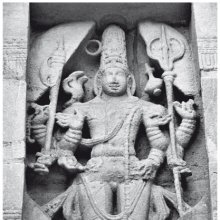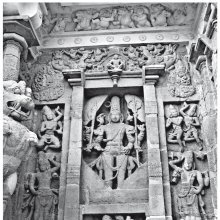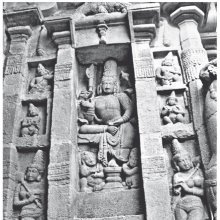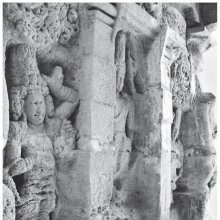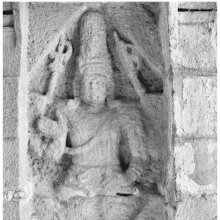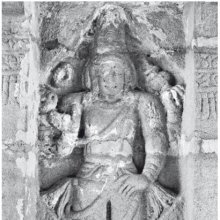Lingodbhavamurti, Liṅgodbhavamūrti, Lingodbhava-murti: 4 definitions
Introduction:
Lingodbhavamurti means something in Hinduism, Sanskrit. If you want to know the exact meaning, history, etymology or English translation of this term then check out the descriptions on this page. Add your comment or reference to a book if you want to contribute to this summary article.
Images (photo gallery)
(+2 more images available)
In Hinduism
Shilpashastra (iconography)
Source: Google Books: Elements of Hindu iconographyThe liṅgodbhavamūrti (लिङ्गोद्भवमूर्ति) is one of the common icons in Southern India, which according to the Āgamas is required to be placed in the niche in the western wall of the garbhagṛha or the central shrine. In the Aṃśumadbhedāgama is found the following description of the liṅgodbhavamūrti: The figure of Śiva in the aspect of candraśekharamūrti should be carved on the front of a liṅga. It is stated in the Kāraṇāgama that one-fifth part of the liṅga should be left out on the top and at the bottom respectively without any sculpture. The legs below the knees of the figure of Candraśekhara carved on the liṅga should be invisible, that is, should be left unsculptured. On the right of the liṅga and near its top Brahmā should be represented in the shape of a swan (haṃsa) while Viṣṇu should be carved in the form of a boar on the left at the foot of the liṅga. The figures of Brahmā and Viṣṇu should be sculptured on the right and left respectibely of the liṅga and also facing it, with two hands held on the chest in the añjali pose. The colour of the figure of Śiva should be red, that of Viṣṇu black and that of Brahmā golden yellow.
Source: Archaeological Survey of India: Śaiva monuments at Paṭṭadakal (śilpa)Liṅgodbhavamūrti (लिङ्गोद्भवमूर्ति) is found as a sculpture on the third pillar of the maṇḍapa of the temple of Kāśīviśveśvara.—In one panel many elements are pictured and the Liṅgodbhava is in two dimensions. In the centre of the panel is Śiva Candraśekharamūrti appearing in the Liṅga. On either side of the Liṅga are standing both Viṣṇu and Brahmā in añjali, folded hands, probably making the eulogy of Śiva. But prior to that when both the gods were fighting for their supremacy over the universe there appears a luminous column. Then the two gods Brahmā and Viṣṇu transform themselves into zoomorphic creatures, the former as a hamṣa, mythical bird, the latter as a Black Boar. They go in search of either ends of the column and fail to find the ends. On realizing their error they begin to praise Śiva.

Shilpashastra (शिल्पशास्त्र, śilpaśāstra) represents the ancient Indian science (shastra) of creative arts (shilpa) such as sculpture, iconography and painting. Closely related to Vastushastra (architecture), they often share the same literature.
Vastushastra (architecture)
Source: Shodhganga: Temples of Salem region Up to 1336 ADLiṅgodbhavamūrti (लिङ्गोद्भवमूर्ति).—This form represents Śiva inside an oval recess in the centre of the Liṅga. Always Brahmā and Viṣṇnu are represented in the form of Swan and Boar. All these sculptures are housed in the koṣṭa of the back wall of the sanctum of the shrines of Śiva and this is according to the Textual prescription. All of the Liṅgodbhavamūrti sculptures have uniform iconographic forms. The quality of carving is also uniform in them.

Vastushastra (वास्तुशास्त्र, vāstuśāstra) refers to the ancient Indian science (shastra) of architecture (vastu), dealing with topics such architecture, sculpture, town-building, fort building and various other constructions. Vastu also deals with the philosophy of the architectural relation with the cosmic universe.
Shaivism (Shaiva philosophy)
Source: Shodhganga: Iconographical representations of Śiva1) Liṅgodbhavamūrti (लिङ्गोद्भवमूर्ति) or simply Liṅgodbhava refers to one of the twenty-three forms (mūrti) of Śiva mentioned in the Pūrvakāmikāgama (pratimālakṣaṇavidhi-paṭala): first and foremost among the Mūlāgama. The forms of Śiva (e.g., Liṅgodbhava-mūrti) are established through a process known as Sādākhya, described as a five-fold process of creation.
2) Liṅgodbhavamūrti or simply Liṅgodbhava also refers to one of the twenty-eighth forms (mūrti) of Śiva mentioned in the Vātulāgama: twenty-eighth among the Siddhāntaśaivāgama.
3) Liṅgodbhavamūrti or simply Liṅgodbhava also refers to one of the eighteen forms (mūrti) of Śiva mentioned in the Kāraṇāgama (pratimālakṣaṇavidhi-paṭala): the fourth among the Siddhāntaśaivāgamas.
4) Liṅgodbhavamūrti is also listed among the ten forms (mūrti) of Śiva mentioned in the Ajitāgama (under the Maheśvararūpa heading): the fifth among the Siddhāntaśaivāgamas.
5) Liṅgodbhavamūrti is also listed among the sixteen forms (mūrti) of Śiva mentioned in the Dīptāgama: the sixth among the Siddhāntaśaivāgamas.
6) Liṅgodbhavamūrti is also listed among the eighteen forms (mūrti) of Śiva mentioned in the Śilparatna (twenty-second adhyāya): a technical treatise by Śrīkumāra on Śilpaśāstra.

Shaiva (शैव, śaiva) or Shaivism (śaivism) represents a tradition of Hinduism worshiping Shiva as the supreme being. Closely related to Shaktism, Shaiva literature includes a range of scriptures, including Tantras, while the root of this tradition may be traced back to the ancient Vedas.
See also (Relevant definitions)
Partial matches: Lingodbhava, Murti.
Full-text: Varaha, Mahesha, Lingodbhava.
Relevant text
Search found 5 books and stories containing Lingodbhavamurti, Liṅgodbhavamūrti, Lingodbhava-murti, Liṅgodbhava-mūrti; (plurals include: Lingodbhavamurtis, Liṅgodbhavamūrtis, murtis, mūrtis). You can also click to the full overview containing English textual excerpts. Below are direct links for the most relevant articles:
Pallava period (Social and Cultural History) (by S. Krishnamurthy)
Ornamental Diagonal Band across the Body < [Chapter 4 - Material Culture of the People]
Armlets (Keyuras) < [Chapter 4 - Material Culture of the People]
Shaivism during the Pallava period < [Chapter 3 - Socio-Religious Life]
The Religion and Philosophy of Tevaram (Thevaram) (by M. A. Dorai Rangaswamy)
Chapter 1.2 - Lingodbhava-murti (depiction of the pillar of fire) < [Volume 2 - Nampi Arurar and Mythology]
Chapter 3.6 - Kalasamhara-murti (Markandeya and the conquest of death) < [Volume 2 - Nampi Arurar and Mythology]
Kashyapa Shilpa-shastra (study) (by K. Vidyuta)
7. Favourable Directions for Installing the Śiva Mūrtis < [Chapter 3 - Prākāra Lakṣaṇa]
Amaravati Art in the Context of Andhra Archaeology (by Sreyashi Ray chowdhuri)
Amarāvatī impact on later schools of Indian art < [Chapter 5 - Impact of Amarāvatī Art]
Early Chola Temples (by S. R. Balasubrahmanyam)
